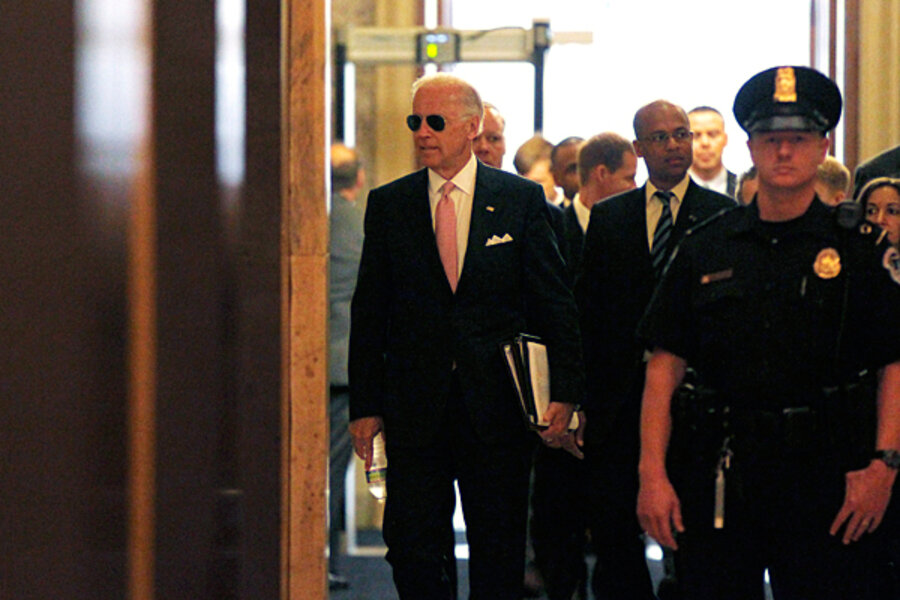Budget math: Is too much 'off the table' to really fix US deficit?
Loading...
Picture a family that gets in over its head in debt. The two heads of the household decide the problem needs urgent attention, but that they won't consider any solutions that involve changes to their income, their mortgage and housing costs, their health care, or their retirement plans.
Now picture that family being the United States, as represented by its elected officials.
That's essentially what's happening now in Washington, as Democrats and Republicans agree on a major problem but not on how to fix it. On Thursday, bipartisan talks led by Vice President Joe Biden continue. After the group met Wednesday, lawmakers expressed optimism about reaching a fiscal deal, even though some key pieces of the nation's finances are currently viewed as "off the table."
Republicans generally don't want to consider raising taxes as part of a plan to reduce federal deficits. And the rift between the two parties over how to fix Medicare and Social Security has pushed those entitlement programs to the sidelines.
So the two parties are focused on other parts of the federal budget – such discretionary spending and where to cut it – as they rush to put a fiscal deal in place before Aug. 2. Both sides agree that it's a good idea to act by early August, ideally a bit ahead of that Treasury-announced deadline, to avoid a serious funding challenge for the nation. After that, the government won't be able to borrow, by issuing new bonds, unless Congress has raised the debt limit.
The limited scope of the bipartisan talks doesn't mean they are fruitless.
In fact, as lawmakers left Wednesday's meeting members of both parties struck an optimistic tone about the progress being made. The group is meeting at a stepped-up pace (it will gather again Thursday, for its third meeting of the week) with the goal of setting a framework for legislation by July 4.
Still, because some key elements of the budget aren't in play, it appears likely that the resulting legislation will be a partial solution to fiscal troubles. To truly put the national debt on a track of stabilization or decline, those "off the table" elements will almost certainly need to be part of the solution.
Here's a glimpse of the math: Social Security, Medicare, Medicaid, and interest on the national debt currently account for nearly half of all federal spending –and that total is poised to grow substantially if no changes are made. They are comparable to the role that housing, health care, and retirement plans play in the typical family budget.
President Obama's bipartisan fiscal commission proposed last year that the government should aim to cut projected federal deficits by about $4 trillion over the next decade. Independent advocates of fiscal responsibility have embraced that goal as roughly the amount needed to halt the rapid growth of public debt and maintain investor confidence in the US economy.
For context, even after making $4 trillion in headway the US would still run deficits totaling perhaps $5 trillion over the next 10 years, but the deficit problem would decline when viewed as a share of the overall economy.
Say you wanted to achieve that whole $4 trillion in progress through spending cuts, without touching Social Security, Medicare, or Medicaid. That would require major cuts, probably on the order of 15 percent, to all other parts of the budget.
That "other" part of the budget includes domestic discretionary programs, defense, and miscellaneous spending programs (such as farm subsidies) that Congress has made mandatory rather than subject to annual appropriations. All this spending is projected by the Congressional Budget Office to total some $21 trillion over the next decade.
The fiscal commission estimated that some of the fiscal progress in its $4 trillion total – about $700 billion worth – would come from reductions in expected interest on the debt. Following that logic, cutting about $3.3 trillion (or 16 percent) of that $21 trillion in projected spending might reach the target.
Note that if Congress decided some programs shouldn't be cut that much, the remaining spending cuts would have to go even higher.
Defense spending is an example – and not just a hypothetical one. National security accounts for nearly half of that $21 trillion in projected spending over the next decade. So if Congress decided to cut security spending by 5 percent, the remaining spending would face cuts of about 25 percent, to reach the target.
Many politicians in both parties are reluctant to cut military spending that much, warning of a possible erosion of national security.
In a hearing on the budget Wednesday, Defense Secretary Robert Gates talked about the tough choices the Pentagon confronts as it enters a likely era of tighter budgets. He said the nation will need to examine goals such as the longstanding notion that America should be able to fight two sizable wars at once, or other ways to reduce spending.
His comments came in response to a question about how to reach an Obama administration goal of $400 billion in defense cuts (a spending reduction of less than 5 percent) over a decade.
Overall, closing the budget gap without adjusting entitlement benefits or taxes would only become more difficult as America looks beyond a 10-year time horizon. That's because of the costs of baby-boom retirements and a related jump in interest costs on the debt.
The upshot of all this analysis: There's room to make some significant headway on the budget deficit by cutting miscellaneous things like farm subsidies, highway funding, and nonessential weapons systems. But that's probably just one piece of a larger puzzle.
For his part, Mr. Biden has said he's optimistic that the bipartisan talks will result in a deal to raise the national debt limit while cutting expected spending by more than $1 trillion. He didn't say over what time frame.





